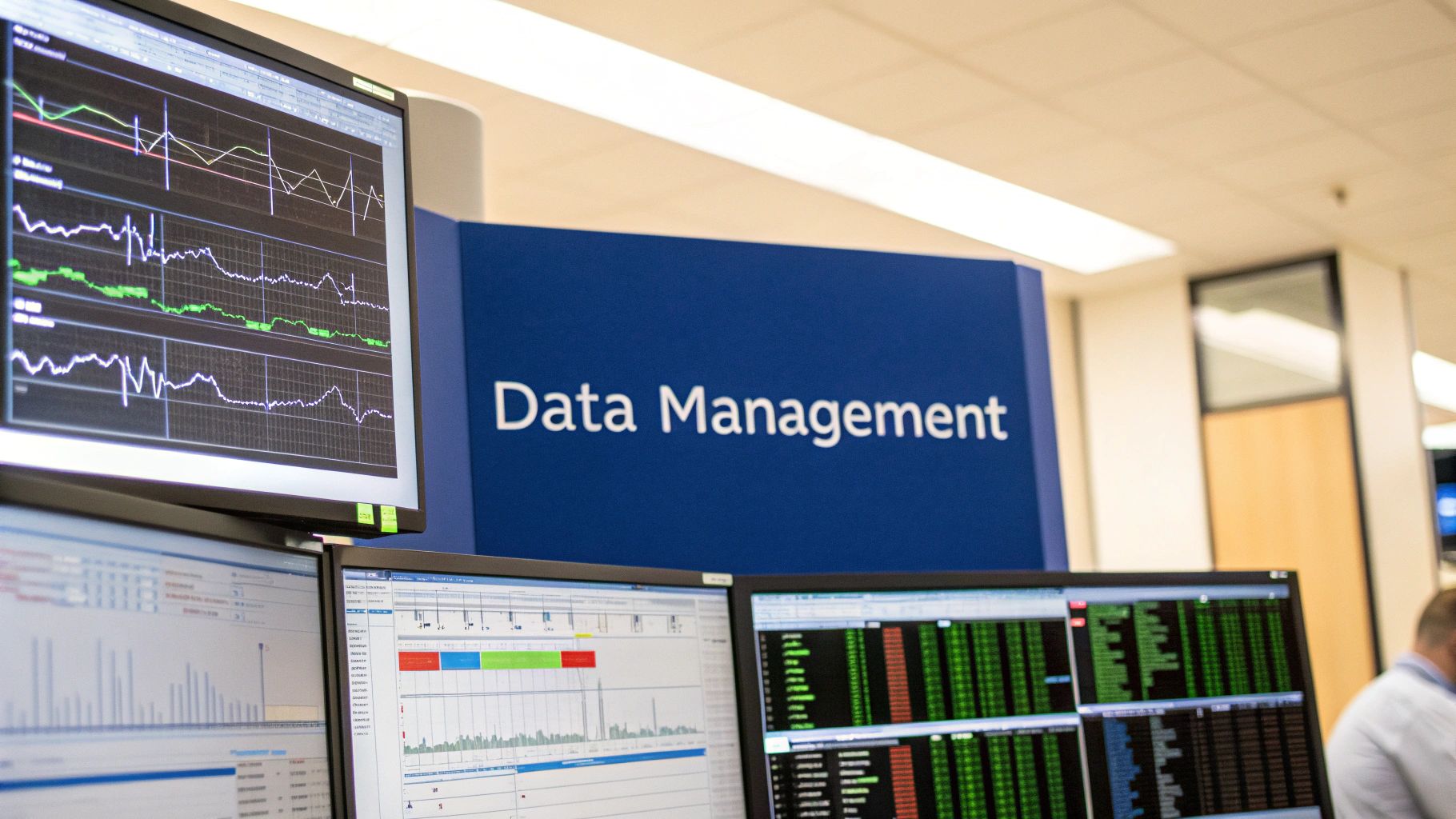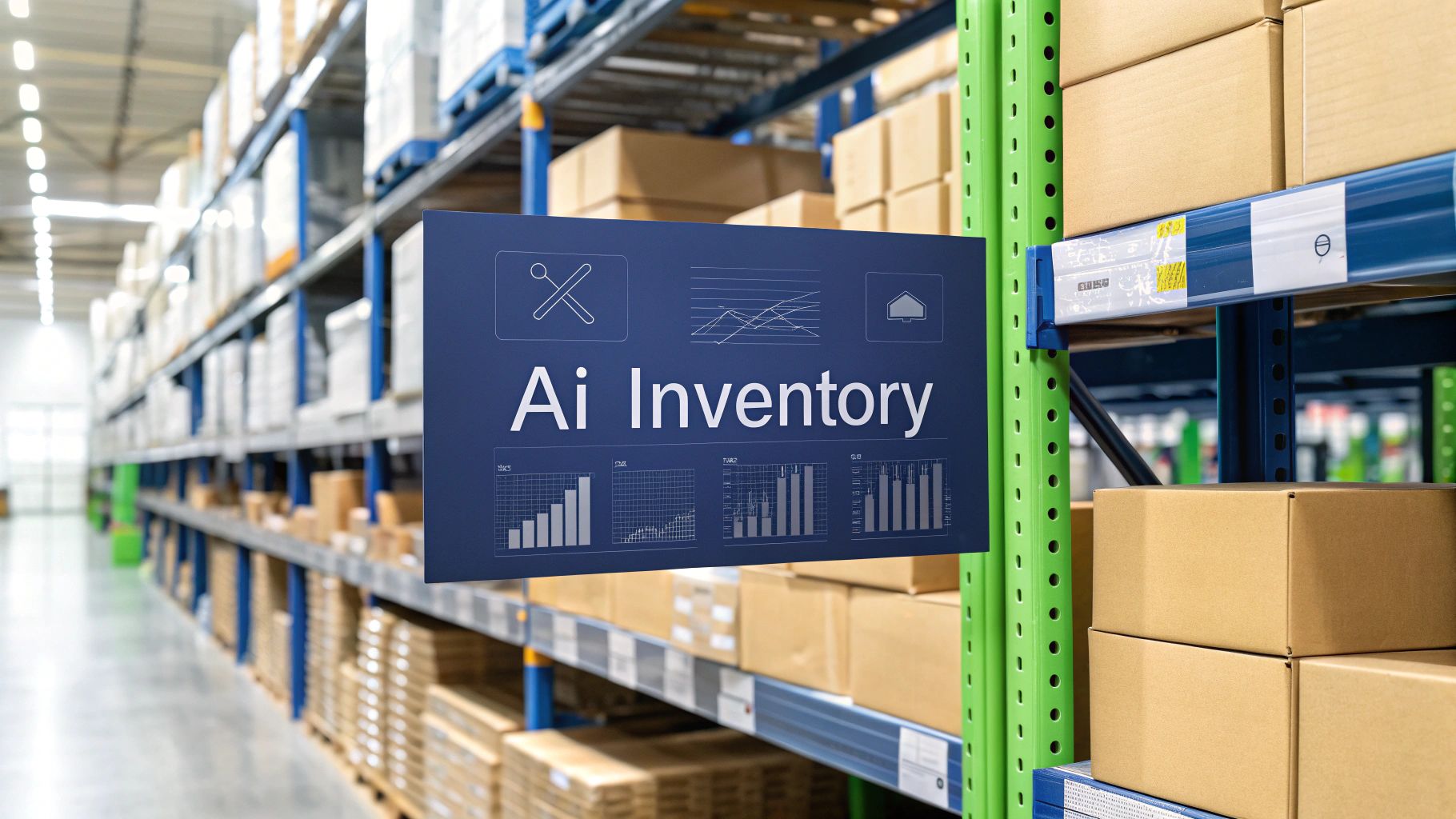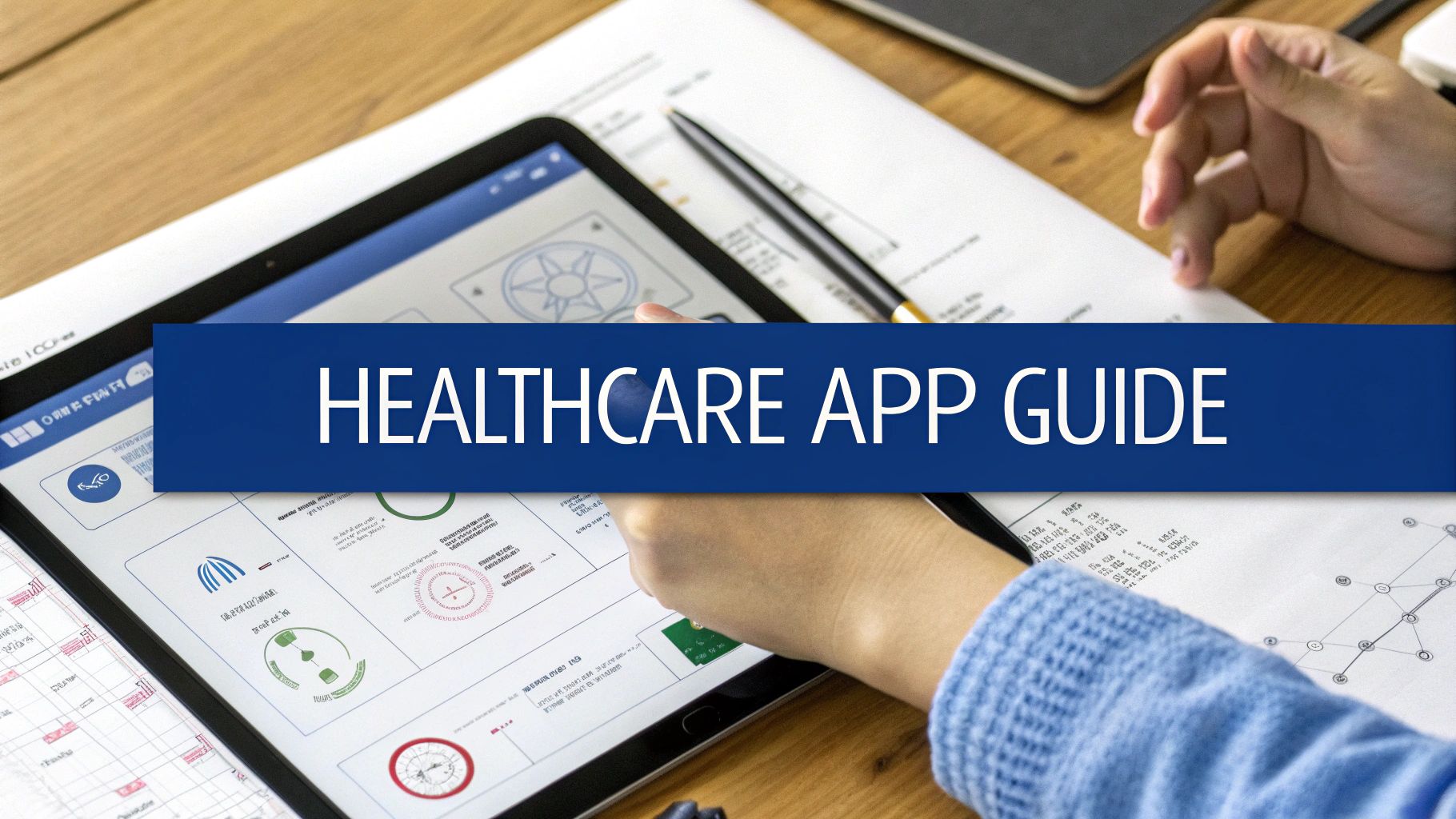At its heart, healthcare data management is the craft of organising, storing, protecting, and making sense of the mountains of information that healthcare organisations produce every single day. Think of it as the central nervous system for everything from patient records to billing details, ensuring the right information is accurate, secure, and available to the right people at the right time. In many ways, it's the invisible backbone of modern medicine.
The Foundations of Healthcare Data Management
Picture a busy air traffic control centre for a moment. Controllers have to track hundreds of flights simultaneously, making sure every pilot has precise, real-time information to get from point A to point B safely. One wrong data point could spell disaster.
That’s exactly what healthcare data management does. It acts as the digital air traffic control for patient information, guiding every piece of data to where it needs to go, safely and efficiently.
This isn't just some IT task relegated to a server room. It’s a core operational function that touches every corner of patient care. When it works well, a doctor in the emergency room can pull up a patient's allergy history from their family physician in seconds. A lab result gets matched to the correct patient file without a hitch. It's this intricate, behind-the-scenes system that upholds both patient safety and operational sanity.
The infographic below really drives home the level of control needed to juggle all the different data streams flowing through a hospital.
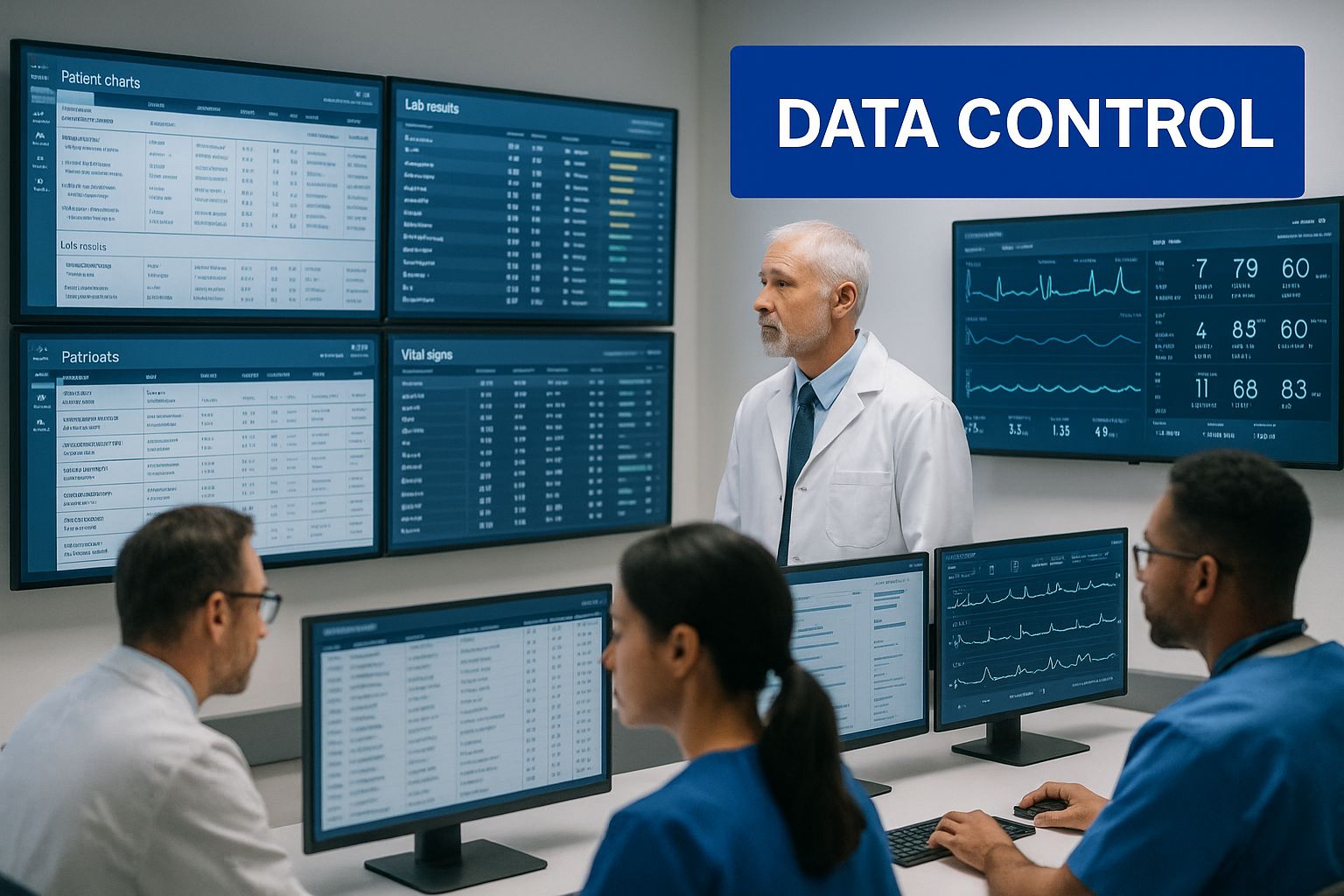
As you can see, a central system has to act as an orchestrator, pulling together everything from clinical charts to administrative files to keep the entire operation running smoothly. Without it, a healthcare facility would quickly grind to a halt.
Key Types of Healthcare Data
The sheer volume and variety of healthcare data are staggering, and it's growing every day. To manage it all, you first have to understand what you're dealing with. These different types of data are all interconnected, and a problem in one area can easily create a domino effect.
Here are the main categories you'll encounter:
-
Clinical Data: This is the information most people think of, things like electronic health records (EHRs), lab results, medical images like X-rays and MRIs, and a clinician's notes. Its accuracy is absolutely critical for making the right diagnosis and planning treatment.
-
Administrative and Financial Data: This bucket holds everything from patient demographics and insurance details to billing codes and claims information. If this data is managed poorly, it can lead to serious revenue cycle issues and frustrated patients.
-
Genomic and Research Data: As personalised medicine becomes more common, genomic data is playing a much bigger role. This category also includes the anonymised data used in clinical trials and population health studies, which helps fuel the discovery of new treatments.
At the end of the day, healthcare data management is about turning raw information into a trustworthy, usable asset. When done right, this data doesn't just make daily operations smoother, but unlocks the insights needed for medical breakthroughs and better patient outcomes.
Mastering this flow of information isn't a "nice-to-have" anymore. It's a fundamental requirement for any healthcare provider that wants to deliver safe, efficient, and high-quality care. After all, every single data point is a piece of a person's health story, and it deserves to be handled with precision and care.
The Core Principles of Managing Health Data
Building a robust healthcare data management strategy is a lot like constructing a modern hospital. You don't start with the roof; you begin with a solid, unshakeable foundation. Skip that step, and even the most sophisticated systems will eventually buckle under pressure. This foundation rests on a few core principles that make sure data isn't just collected, but is also reliable, secure, and genuinely useful for improving patient care.
Think of these principles as the guiding pillars for every decision made about a patient's information. They shape how data is handled, who gets to see it, and how different computer systems talk to each other. Getting them right is a slip-up in any one area can have immediate and serious consequences for patient safety and the smooth running of a clinic or hospital.
The table below breaks down these fundamental principles, explaining what they mean in practice and why they are so critical for delivering quality care.
Core Principles of Healthcare Data Management
|
Principle |
Description |
Why It Matters for Patient Care |
|---|---|---|
|
Data Integrity & Accuracy |
Ensuring that all health information is complete, accurate, consistent, and has not been improperly altered. It’s the commitment to the “truth” of the data. |
An incorrect dosage, a wrong lab value, or a misrecorded allergy can lead to severe medical errors. Clinicians must trust the data to make life-saving decisions. |
|
Accessibility & Availability |
Making sure that authorised personnel can access the right patient data, at the right time, from the right place. |
In an emergency, instant access to a patient’s medical history or allergies can be life-or-death. It also ensures seamless care as patients move between departments. |
|
Interoperability |
The ability of different IT systems and software applications to communicate, exchange data, and use the information that has been exchanged. |
This prevents data from being “trapped” in one system. It allows a specialist to see notes from a family doctor, reducing redundant tests and fragmented care. |
|
Security & Privacy |
Protecting sensitive patient information from unauthorised access, use, or disclosure, while complying with regulations like PIPEDA. |
Breaches erode patient trust and can lead to identity theft or fraud. Strong security is non-negotiable for maintaining confidentiality. |
|
Compliance |
Adhering to all legal, regulatory, and ethical standards governing health data, including provincial and federal privacy laws. |
Failure to comply can result in massive fines, legal action, and reputational damage, ultimately disrupting care delivery. |
Understanding these principles is the first step. Now, let's explore a few of the most critical ones in more detail.
Upholding Data Integrity and Accuracy
The first and most important principle is data integrity. At its heart, this is a commitment to truthfulness. It means the information in a patient's file is correct, complete, and hasn't been accidentally or intentionally corrupted. A single incorrect digit in a medication dose or a misplaced decimal in a lab result can lead to devastating outcomes.
Maintaining integrity requires putting checks and balances in place at every step. This involves validating data as it's entered, creating audit trails to track any changes, and setting up clear protocols for correcting mistakes. When clinicians trust the data in front of them, they can make critical decisions with confidence.
"The bedrock of effective healthcare is trust. Patients trust their doctors, and doctors must be able to trust their data. Without uncompromising data integrity, that entire structure of trust is jeopardised."
This commitment to accuracy goes beyond just avoiding clinical errors. It's also crucial for the business side of healthcare, where precise data ensures correct billing, smooth insurance claims, and efficient management of hospital resources.
Ensuring Timely Accessibility and Availability
Accurate data is completely useless if you can't get to it when it matters most. Accessibility means that authorised people, from a surgeon in the operating room to a nurse on the ward, can pull up the right information at the right time.
Picture a doctor in the emergency department trying to treat an unconscious patient. Immediate access to their medical history, allergies, and current medications can literally be the difference between life and death.
This principle is all about breaking down data silos. Information shouldn't be locked away on one department's server or stuck in a piece of software that doesn't play well with others. The goal is to create a single, unified view of the patient that's available on demand through secure systems. This ensures continuity of care, whether a patient is visiting their family doctor or being admitted to a hospital.
Achieving Seamless Interoperability
Finally, interoperability is what allows different systems, clinics, and even hospitals to communicate with each other. It’s the digital equivalent of a universal language.
When systems are interoperable, a patient's health records can travel with them, moving effortlessly from a primary care clinic to a specialist's office and on to a pharmacy. Without it, patient information gets trapped, leading to redundant tests, delayed diagnoses, and disjointed care.
The aim is to create a connected healthcare ecosystem where data flows freely yet securely. This level of coordination is vital for managing complex conditions and improving the health of entire communities. For example, initiatives in California are showing how integrated data supports better care management for vulnerable populations, with some programs seeing enrolment increases of over 100% by coordinating services effectively. You can learn more about how California is advancing care through data integration.
These three principles, integrity, accessibility, and interoperability, don't exist in a vacuum. They're deeply connected, weaving together to form the essential framework for any successful healthcare data management strategy.
Navigating Data Security and Compliance

In healthcare, a data breach is a profound violation of patient trust. Managing healthcare data effectively means facing the high-stakes reality of security and compliance head-on. This isn't just about avoiding hefty fines; it's about honouring the fundamental duty to protect someone's most personal and sensitive information.
Think of your healthcare data management system as a digital vault. It’s not enough to have strong walls. You need multiple layers of defence, constant monitoring, and strict rules for who gets a key. A single weak link can compromise the whole structure, leading to devastating consequences for patients and your organisation alike.
Decoding Key Regulations
Trying to navigate the web of data privacy laws can feel overwhelming. But at their core, they all exist for one reason: to protect patients. In Canada, the main piece of federal legislation is the Personal Information Protection and Electronic Documents Act (PIPEDA), which sets the ground rules for how private-sector organizations collect, use, and disclose personal information.
That's only part of the story, though. Healthcare is primarily regulated provincially. This means each province has its own specific health privacy laws, like Ontario's PHIPA or Alberta's HIA, which often have even more stringent rules for handling Personal Health Information (PHI). For any healthcare provider, getting to know these local requirements is essential.
These regulations aren't just dry legal texts; they provide a practical framework for building trust. They require organizations to implement reasonable safeguards, be transparent about how they handle data, and get meaningful consent from individuals. To explore this further, you can learn more about the intersection of https://www.cleffex.com/blog/ai-in-healthcare-data-privacy-canada/.
Building Your Digital Vault
Protecting patient data demands a multi-layered security strategy, where every component reinforces the others. In a world of constantly evolving cyber threats, a proactive defence is the only approach that works. Staying vigilant against dangers like the rising threats of infostealer malware and data breaches is critical to safeguarding sensitive health information.
Key safeguards form the foundation of this digital vault:
-
End-to-End Encryption: This is like an unbreakable seal on data, whether it's stored on a server (at rest) or being sent over a network (in transit). Even if someone unauthorized gets their hands on the data, it remains unreadable and useless without the encryption key.
-
Multi-Factor Authentication (MFA): A password alone just doesn't cut it anymore. MFA requires users to provide at least two different verification factors to log in, creating a powerful barrier against unauthorized access, even if a password is stolen.
-
Access Control and Role-Based Permissions: This simple principle ensures people can only see the specific data they need to do their jobs. A billing clerk, for instance, has no reason to access a patient's detailed clinical notes, and your system should enforce that.
The goal of robust data security is to make sensitive information as difficult and costly to access as possible for malicious actors. By layering multiple defences, you create a formidable barrier that protects patient confidentiality and organisational integrity.
Don't forget the human element. Continuous staff training is another critical layer of defence. Your employees are often the first line of defence, and regular education on spotting phishing attempts, understanding privacy policies, and following security protocols can stop many breaches before they even start.
The High Cost of a Security Failure
The fallout from a data breach goes far beyond financial penalties. While the costs are indeed staggering, the damage to your reputation can be even more severe. Patients give you their most vulnerable information, and a breach shatters that trust, often for good.
Healthcare data breaches remain a significant risk with a massive price tag. In 2025, the average cost of a healthcare data breach was reported to be around $7.42 million. In the U.S., that figure jumps to an average of $10.22 million due to a more complex regulatory and legal environment.
Consider a large market like California, which had 36.2 million people with health insurance coverage in 2023. The sheer scale of potential exposure makes robust security a non-negotiable priority for every single organization.
Ultimately, investing in security and compliance isn't an expense. It's an essential investment in patient safety, public trust, and the long-term health of your organization itself.
The Technology Powering Modern Health Data
To really understand what's happening with healthcare data management today, you have to look under the bonnet at the engine making it all run. The days of endless paper files are thankfully behind us, replaced by a sophisticated network of digital tools that store, analyse, and protect patient information. This technology stack isn't just about turning paper into pixels; it's about building a smarter, more connected healthcare system from the ground up.
At the very heart of this system, you’ll find Electronic Health Record (EHR) systems. The simplest way to think of an EHR is as the patient’s official digital chart. It’s a live, patient-focused record that holds everything from medical history and diagnoses to medications, allergies, and lab results.
Imagine a doctor updating a patient's medication in an EHR. That change is instantly available to a specialist in a completely different department. This creates a single source of truth, dramatically cutting down on the kinds of errors that used to happen when crucial information was scattered across different paper files or siloed computer systems.
The Rise of Cloud Platforms and Data Warehouses
While clinicians use EHRs every day, all that data they generate needs a secure and expandable home. This is where cloud platforms enter the picture. Services from providers like Amazon Web Services (AWS), Microsoft Azure, and Google Cloud give healthcare organisations secure, compliant, and practically limitless storage.
Instead of trying to maintain costly and complicated servers in a hospital basement, organisations can now use the cloud to store everything from patient records to high-resolution medical images safely. This move doesn't just save money; it also makes disaster recovery more robust and gives authorised users access to the data they need, wherever they are.
Going beyond basic storage, data warehouses play another vital role. If you think of an EHR as a single patient’s biography, a data warehouse is like the entire library, holding all the aggregated clinical and operational data from across the whole organisation.
A data warehouse gives leaders the ability to see the bigger picture. They can analyse patient outcomes across different demographics, spot bottlenecks in the emergency department, or track how effective new treatments are on a large scale.
This is the point where raw data starts becoming genuine intelligence. By bringing all this information into one central place, data warehouses allow for complex analysis and reporting that would be completely impossible with separate systems, setting the stage for even more advanced analytics.
The Intelligent Layer of AI and Machine Learning
Some of the most exciting progress in health data is happening in the analytics layer, driven by Artificial Intelligence (AI) and Machine Learning (ML). These technologies act like an intelligent brain, sifting through massive datasets to find patterns and make predictions that are far beyond human capability.
This kind of smart analysis is already making a huge difference in patient care and hospital operations.
-
Predictive Analytics: AI models can comb through thousands of patient data points, like vital signs, lab results, and medical history, to predict the likelihood of someone developing a condition like sepsis or having a heart attack. This gives clinical teams a chance to step in proactively, often before obvious symptoms even appear.
-
Personalised Medicine: By looking at a patient's genetic information alongside their clinical data, machine learning algorithms can help doctors pinpoint the most effective treatment plan for that specific person, moving us away from a one-size-fits-all approach to medicine.
-
Operational Efficiency: AI is helping hospitals streamline everything from scheduling surgeries and allocating staff to managing medical supplies. For instance, predictive models can forecast patient admission rates, helping administrators to make sure they have enough staff on hand to reduce wait times.
This entire technology stack, from the foundational EHR to the predictive power of AI, works as a single, cohesive system. Each layer builds on the one before it, turning individual data points into a powerful asset that makes healthcare better, faster, and safer. It's the invisible engine driving the next generation of medicine.
Turning Data Into Better Patient Outcomes
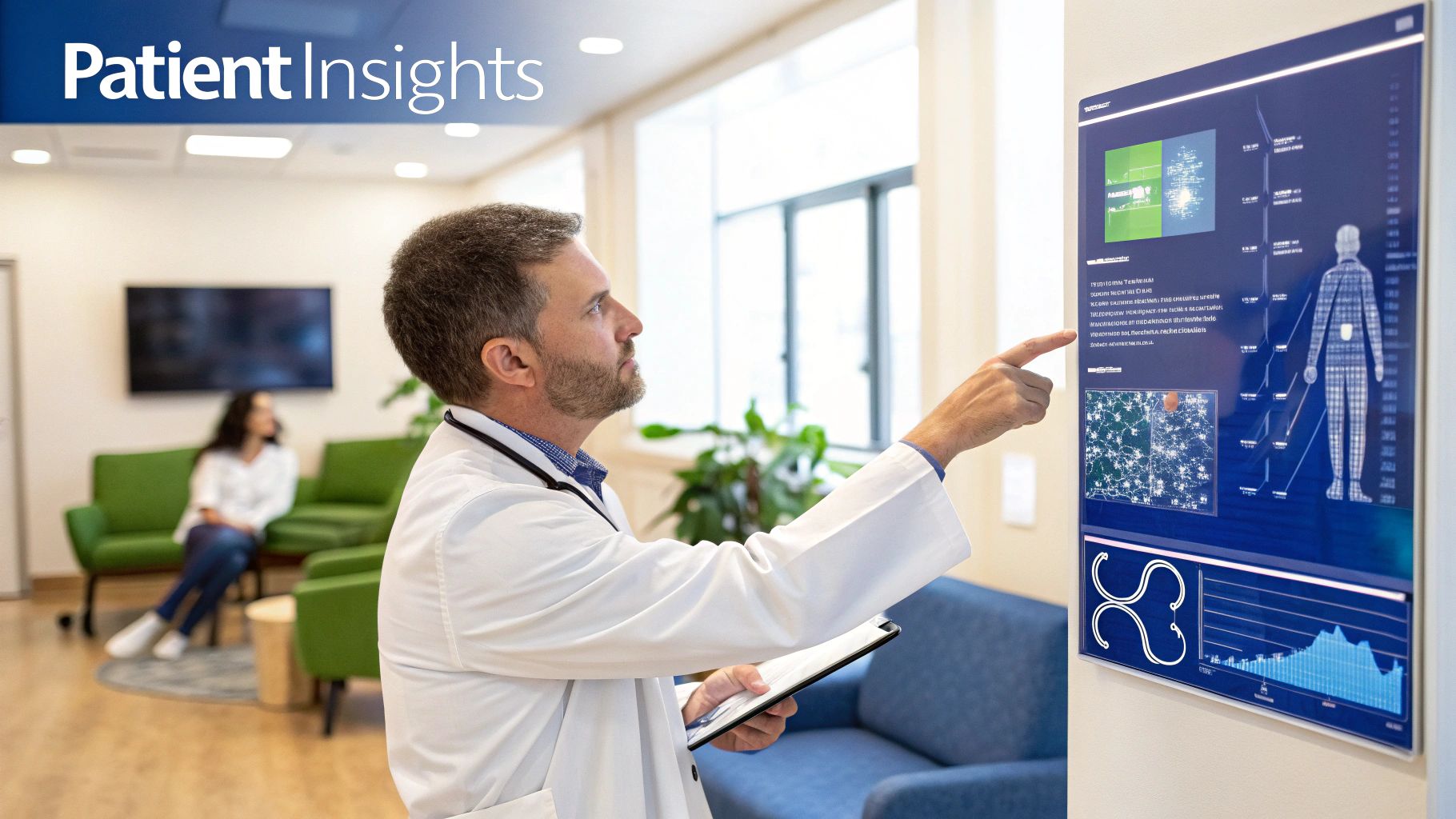
Piling up health data is one thing; putting it to work is another entirely. The real magic of healthcare data management happens when we stop just storing information and start using it to improve, and even save, lives. This is where we see raw data get its purpose, becoming the intelligence that drives better patient outcomes.
This shift is already taking place in hospitals and clinics every day. With the right analytics, healthcare providers can finally get ahead of problems, moving from a reactive stance to a proactive one. It’s the difference between treating a crisis and preventing it from ever happening in the first place.
From Prediction to Prevention
One of the most exciting frontiers is predictive modelling. By sifting through enormous datasets of patient information, machine learning algorithms can spot subtle patterns that would be impossible for a human to see. These models can flag patients who are at high risk for developing serious conditions, giving clinical teams a vital head start.
Take the fight against sepsis, a life-threatening response to infection. Predictive models can monitor a patient's vital signs, lab results, and clinical history in real-time. If the system detects a combination of factors pointing to a high sepsis risk, it alerts doctors and nurses, often hours before obvious symptoms emerge. That early warning is critical, allowing for immediate intervention that can dramatically improve a patient’s chances of survival.
This proactive thinking doesn't just apply to individuals; it scales up to entire communities. During an infectious disease outbreak, public health officials rely on population health data to:
-
Track the Spread: Analyse geographic data to see where the disease is moving fastest.
-
Identify Vulnerable Groups: Pinpoint demographics that are most at risk, helping to focus public health campaigns.
-
Allocate Resources: Send medical supplies, testing kits, and staff to the areas that need them most.
Streamlining Hospital Operations for Better Care
Beyond the clinical side, operational analytics are also changing how hospitals run, which directly impacts the patient experience. Clunky, inefficient processes lead to frustrating delays and can even compromise care. By analysing operational data, hospitals can find and fix these bottlenecks.
Emergency room wait times are a perfect example. Hospitals now use data analytics to forecast patient arrival patterns based on the time of day, day of the week, and even local events. This allows them to adjust staffing dynamically, making sure more doctors and nurses are on shift during peak hours. The result? Shorter wait times and better care. The same logic helps optimise surgical schedules, manage bed availability, and keep medical supplies from running out. For a deeper dive into how technology is reshaping these interactions, our guide on patient data management with AI offers more detail.
This is the ultimate goal of healthcare data management: to create a system where every piece of information, from a single lab result to a city-wide health trend, works together to make care safer, smarter, and more effective for everyone.
This push toward data-informed decision-making is also happening at the provincial level. In California, for instance, the Department of Health Care Access and Information (HCAI) is boosting transparency with its Data Analytics Public Reporting Plan for 2025. This plan aims to release a series of analytics products to help shape healthcare policy and improve outcomes across the state.
Building a Future-Proof Data Strategy
Effective healthcare data management isn't a project you can just check off a list. It’s an ongoing commitment, a promise to build a data ecosystem that is both tough and flexible enough for whatever comes next. To build a strategy that lasts, you need to look past today's immediate problems and prepare for the next wave of medical and tech breakthroughs. This boils down to a practical roadmap built on solid governance, smart technology choices, and a culture that genuinely sees data as a vital asset.
The bedrock of any lasting strategy is strong data governance. Think of it as the constitution for your data. It lays out who owns what, sets the bar for quality, and establishes clear rules for how data can be accessed and used. Without this framework, even the most advanced technology can quickly descend into chaos. Governance ensures everyone, from the front desk to the C-suite, understands their part in safeguarding and using data properly.
From there, the focus shifts to people. You need to cultivate a data-informed culture. This means giving every team, from clinicians to administrators, the tools and training they need to make decisions based on evidence, not just gut feelings. The goal is to make data accessible and easy to understand, transforming it from a niche tool for analysts into a shared resource that helps everyone improve patient care and streamline operations.
Preparing for the Next Wave
A forward-thinking data strategy doesn't just solve today's problems; it anticipates tomorrow's. Keeping an eye on emerging technologies allows you to build a foundation that is flexible enough to integrate innovations when they're ready for prime time.
A few key areas to watch are:
-
Personalised Medicine: Genomic data is becoming more and more common. Your systems need to be prepared to manage and analyse this highly sensitive information to help tailor treatments to an individual’s unique genetic profile.
-
Internet of Medical Things (IoMT): We're seeing an explosion of connected devices, from wearable fitness trackers to smart hospital beds. These gadgets generate massive, continuous streams of real-time data that must be captured, integrated, and interpreted.
-
Advanced Analytics: Your infrastructure has to be ready to scale. It needs to support the increasingly complex AI and machine learning models that will power predictive health alerts and even automate parts of the diagnostic process.
Creating a sustainable data ecosystem is less about chasing every shiny new trend and more about building a strong, flexible core. The goal is a system that can evolve right alongside the healthcare industry, delivering real value for years to come.
Ultimately, a successful strategy is a careful balance of technology and talent. Investing in the right tools is absolutely critical, but so is investing in the people who will use them. For a deeper dive into structuring these complex systems, exploring different enterprise application architecture patterns can offer some great insights into building solutions that are both scalable and easy to maintain. By combining a clear vision with these practical steps, you can confidently build a data strategy that’s ready for whatever the future holds.
Frequently Asked Questions
It's natural to have questions when dealing with something as complex as healthcare data management. Here, we've tackled some of the most common ones we hear, breaking them down into clear, straightforward answers.
What is the Biggest Challenge in Healthcare Data Management?
Without a doubt, the single greatest challenge is achieving true interoperability.
Think of it this way: every hospital, clinic, lab, and pharmacy is like its own country, speaking its own unique language. When they try to share patient information, it's like trying to have a conversation without a translator. The result is a collection of isolated data "islands," or silos, where critical information gets trapped.
This fragmentation is more than just an inconvenience; it can lead to incomplete patient histories, repeated tests, and even dangerous medical errors. While other issues like security and the sheer volume of data are huge hurdles, the inability for different systems to speak to one another is the root problem we need to solve.
The ultimate goal is for a patient's complete health record to follow them securely wherever they receive care. True interoperability is the bridge that makes this possible, turning fragmented data points into a cohesive, life-saving narrative.
Fixing this isn't just about technology. It demands a united effort across the industry to agree on standard data formats and secure ways for systems to connect and share information.
How is Cloud Computing Changing Healthcare Data Storage?
Cloud computing has completely reshaped how healthcare providers think about data storage. It offers a secure, flexible, and much more cost-effective approach compared to the old way of doing things.
In the past, a hospital had to buy, set up, and maintain its own expensive servers on-site. This was a massive capital expense, and scaling up or down was a slow, difficult process.
Today, cloud platforms like Amazon Web Services or Microsoft Azure flip that model on its head. They provide:
-
Elastic Scalability: A facility can instantly increase or decrease its storage capacity as needed, paying only for the resources it actually uses. This is essential for managing massive datasets from things like MRI scans or genomic research.
-
Better Accessibility: Authorized doctors and nurses can securely access patient files from anywhere, on any approved device. This is a game-changer for telehealth and for care teams that need to collaborate from different locations.
-
Top-Tier Security and Recovery: Major cloud providers invest heavily in advanced security and have the certifications to prove they can handle sensitive health information. They also offer robust disaster recovery, ensuring patient data is safe and accessible even if a hospital's physical location is affected by a fire or flood.
What is the Difference Between an EHR and an EMR?
While the terms are often tossed around as if they're the same, there’s a crucial difference between an Electronic Health Record (EHR) and an Electronic Medical Record (EMR).
An EMR (Electronic Medical Record) is basically the digital version of a patient's old paper chart. It contains the medical and treatment history from one single doctor's office or clinic. It’s an internal record that doesn't usually travel outside that practice.
An EHR (Electronic Health Record), on the other hand, is the big picture. It’s designed to be a comprehensive snapshot of a patient's total health journey, pulling in information from all the clinicians involved in their care. The EHR is built to be shared securely, so it can follow a patient from their family doctor to a specialist, to the hospital, or even to a new clinic in another province.
Simply put: an EMR is a single chapter written by one author, while an EHR is the patient's entire life story, co-authored by every provider they've ever seen.
At Cleffex Digital ltd, we build secure, compliant, and intelligent software solutions that empower healthcare organisations to harness the full potential of their data. Let's build the future of healthcare together.
